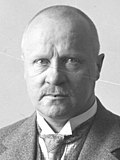Background
In 1919, Finland was still reeling from the violent and traumatic effects of its Civil War. Many Whites (rightists and centrists) felt that a strong national government was necessary to prevent a new civil war. Some conservatives, especially monarchists, even wondered if Finland should keep its democracy and universal right to vote. For example, Carl Gustaf Emil Mannerheim, in the White Army's victory parade in Helsinki in May 1918, called for giving the leadership of Finland's to a strong leader, free from partisan wrangling.
Liberals, such as the first President Kaarlo Juho Ståhlberg, believed that discontent with Finland's political, social and economic order would be removed by making reforms. Monarchists had elected the German Prince Frederick Charles of Hesse as the Finnish king in October 1918, but he had renounced the throne in December 1918, conscious of the problems that Finland would have in its relations with the winners World War I if it had a citizen of the defeated Germany as its king. The republican parties (the Social Democrats, Agrarians and Progressives) disagreed on how much power the president should have. The monarchist parties (the National Coalition Party and the Swedish People's Party of Finland) wanted a strong presidency if there was going to be a republic at all.
In the end, enough Finnish voters sided with the republican parties, which also promised significant social reforms, such as the freeing of tenant farmers and the distribution of excess farmland to them. [3] [4] [5]
This page is based on this
Wikipedia article Text is available under the
CC BY-SA 4.0 license; additional terms may apply.
Images, videos and audio are available under their respective licenses.






